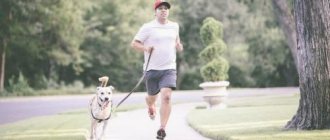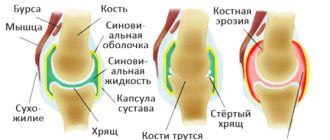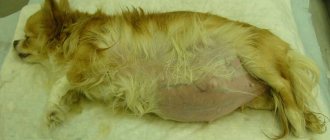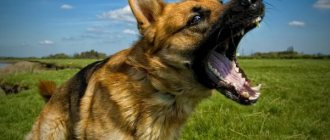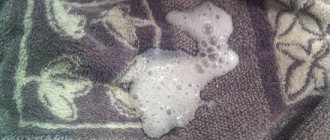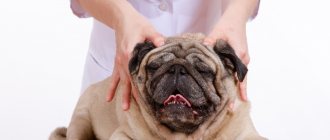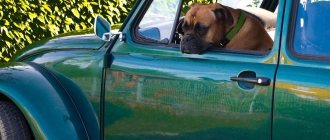Benefit
For the first time in their lives, dogs are introduced to massage in infancy. When a mother licks her newborn puppies, she helps them breathe. When the cubs grow up, the mother kneads their tummies. This manipulation prevents constipation.
Massage for dogs is also necessary in adulthood. This is a good means of treating and preventing diseases. The benefits of massage treatments are as follows:
- Massaging movements stimulate blood circulation. As a result, blood flows to a certain area of the body, tissue nutrition and local metabolism improves. This promotes faster healing of injuries, which is why massage is often prescribed for injuries.
- The procedure stimulates the motor nerves. Therefore, massage is necessary for paralysis and weakness of the paw muscles. This rehabilitation activity helps restore movement.
- Massage helps to relax and calm the nervous system. This procedure is useful for a dog after experiencing stress, difficult training or an exhibition.
- Massage procedures improve peristalsis and facilitate easy bowel movements.
In many cases, dog massage can be done on your own. However, if your pet is seriously ill, the procedure should be performed by a professional. Not all types of massage treatments can be done at home.
Types of massage for dogs
Veterinarians distinguish the following types of massage for animals :
- preventive . It is produced to relax muscles and increase their tone, warms the body;
- medicinal _ It is done for arthrosis, dislocations, fractures, vertebral pathologies, sprains, and so on. Without it, a course of therapy is impossible;
- hydromassage. This is a type of medical procedure, it is done in special veterinary clinics. The dog is placed in a vat of warm, bubbling water. Thanks to this, tissue nutrition and blood supply improve, the body becomes toned and strengthened;
- Hydromassage
- wellness _ The presence of injuries or operations on the spine is an indication for regular sessions. They will help the dog return to normal life sooner;
- cosmetic . It is done in special salons for dogs to improve the appearance of their coat. Specialists have powders with vitamins for hair, aromatic oils, emulsions, and so on.
All of these procedures, with the possible exception of hydromassage, can be done independently if you master the technique. But if the dog is seriously ill, and you are not confident in your abilities or are afraid of harm, it is better to consult a specialist. You can also watch the veterinarian perform the procedure for several sessions, and then repeat.
You can do massage yourself if you master the technique.
Indications
For what diseases is massage for dogs indicated? This procedure is effective for the following pathologies:
- diseases of the musculoskeletal system;
- injuries;
- constipation;
- inflammation and degeneration of joints;
- pain syndrome of various origins;
- neurotic disorders.
Healthy dogs should also get massages regularly. This will help your pet maintain a healthy musculoskeletal system into old age, as well as relieve stress and relax.
How to massage your pet: technique
If you want to provide manual therapy to your pet at home, then first of all, choose a suitable place. You will need a hard, flat surface, such as a table. It must be covered with soft cloth. A double-folded blanket or terry sheets will do. You can also put them on the floor - it is important that the dog feels calm and comfortable. Also, preparing a dog for a massage involves putting on a muzzle if it is aggressive.
Start by laying down something soft and playing soothing sounds from nature.
The technique consists of the following hand movements: gentle stroking, kneading the skin like dough, shaking the skin, vibration, rubbing and very light tapping with your fingertips. Ironing should begin and end every activity. Massage is done with the pads of the fingers or with the lower flat surface. It varies, but there is a common technology. This is done like this:
- Lay your dog down and start stroking, this will relax the muscles and calm him down. This way you can establish contact with her and promote relaxation;
- start kneading. First, soothingly knead your dog's body, and then stimulate the skin. If you massage a small surface, then do it with your thumbs, and if you massage a large part, then do it with the lower surface of your middle, index and ring fingers. Swipe them in a circle;
- To activate blood circulation, it is necessary to shake. Pinch the skin and shake. If your dog is nervous, speak to him in a calm voice;
The sooner the animal relaxes, the more effective the massage will be.
- To influence deep muscles and ligaments, you need to use vibration techniques. Be sure to do them at a calm pace so as not to irritate the four-legged one;
- To increase blood flow and eliminate adhesions, it is necessary to rub the tissue. This is most often done for diseases of the spine. If you only need to eliminate stress and supply tissues with oxygen or stimulate large muscles, use effleurage. Remember, if the dog begins to snap and react strangely, stop. She may be feeling pain in that part of her body;
- finish by stroking the entire body from head to tail.
Contraindications
There are times when massage is contraindicated. This procedure should not be done under the following conditions:
- fever;
- any injuries and lesions of the skin (eczema, tumors, wounds, pustules);
- bleeding;
- fresh bone injuries with severe pain;
- epilepsy;
- severe liver and kidney diseases;
- shocked.
If your dog has at least one of the listed contraindications, then refuse massage. Otherwise, the treatment procedure will do more harm than good.
Contraindications to massage
It is important to remember that this is a medicinal thing, so it has contraindications. These include:
- eczema;
- purulent infections;
- neoplasms;
- open wounds;
- increased body temperature;
- bleeding;
- epilepsy;
- inflammation;
- state of shock;
- fresh fracture with pain.
Be sure to consult your veterinarian before performing a massage.
Attention! If you have at least one item from the list, do not touch your pet! Even if there are no contraindications, it is still advisable to consult with a veterinarian before starting sessions - he will tell you what exactly is right for your animal and teach you the basic techniques.
Some tips
Before giving your dog a massage, check out the following advice from veterinarians:
- You will need a basic knowledge of canine anatomy and physiology. You can learn about the characteristics of the animal’s body from a veterinarian. You can also find this information yourself on dog breeding websites.
- During the procedure, turn your pet over to massage first one side and then the other. Try not to press on the stomach; this part of the body can only be lightly stroked. Otherwise, the abdominal organs may be damaged.
- If your pet is diagnosed with a serious illness, then it is better to entrust massage treatments to a specialist.
- If you give a preventative massage to a healthy dog, then the procedures should be regular. Try to spend at least 10 minutes on this every day. This will be a good prevention of the development of arthritis.
- If your pet is healthy, then pay attention to its reaction to the procedures. If the dog shows dissatisfaction (growls, flinches), then do not force it. You need to gradually accustom your animal to massage.
Adviсe
An owner who wants to learn how to massage their pet should familiarize themselves with some basic recommendations:
- Before starting manual therapy, learn the basics of canine anatomy and physiology. You can research this yourself online or ask your veterinarian;
- Spend 10 minutes daily massaging a healthy dog. This way, her muscles and joints will remain in good condition - in old age there will be no problems with limb atrophy or pain. She will also be happier and more content;
- First, crumple one side of the pet, then transfer it to the other. Do not touch the stomach at all or just stroke it lightly - otherwise you can damage the internal organs;
Abdominal massage should be done last.
We do a general massage
Veterinarians recommend general massage to prevent disease. The methodology for carrying it out is as follows:
- Cover a hard surface with a soft cloth. Place your pet on it and stroke it from head to back.
- Massage the back first with your fingers and then with your palms. Gently knead the skin, trying not to put pressure on the spinal column.
- Focus on the sacrum. Massaging this area prevents joint diseases.
- Rub your paws from top to bottom. Then bend and straighten each finger.
- Gently pat your pet's belly. At the same time, avoid sharp pressure.
- Now move on to massaging the muzzle. Take the cheeks with your fingers. Lift them up and then lower them down. Stroke the chin, as well as the area around the nose and eyes.
Complete the procedure by stroking the tail from base to tip.
Massage for stress prevention
Massage is widely used to prevent and relieve stress. In addition, the massage process has a positive effect on the person doing it. Research has shown that tactile contact with pets has beneficial effects on people. It is very likely that the effect also has a reverse effect - for dogs, physical contact is just as important as for people. The very touch strengthens the emotional connection with the animal, especially with a young dog. From the first moments of life, the puppy recognizes care and love from the touch of its mother during licking (a gentle form of massage). And for adult animals, physical contact with the owner and family members is of great importance.
Relieving pain
How to massage a dog if something hurts your pet? The procedure technique is as follows:
- Place the dog on a blanket or the floor, make petting movements and talk to the dog in a soft voice.
- Rub your shoulders, neck and back in circular motions, as if you were kneading dough. Do not put too much pressure on your body, as this may increase the pain.
- Gently stretch your paw muscles. Move from their base down. Don't forget to massage your fingers.
- Direct impact on the source of pain is prohibited. You can only stroke and knead the muscles around the sore spot. This will help improve blood circulation and reduce discomfort. Be especially careful if your dog suffers from cancer. Try not to touch the tumors, this may provoke their growth.
- Complete the procedure by lightly stroking the entire body from head to tail and each paw.
Indications for physiotherapy
Rehabilitation and physical therapy methods and their diversity allow a specialist to develop an optimal plan for comprehensive recovery after surgery or for the process of treating a chronic disease, which in turn provides comprehensive care for the patient.
A timely visit to a doctor to develop a rehabilitation plan is the key to making the recovery process in the postoperative period less painful for the patient. And restoration of lost functions will take less time.
In our clinic, during a doctor’s appointment, a rehabilitation plan will be developed for the patient using myo-electro-stimulation, transcutaneous neuro-electric stimulation (according to indications).
Helping the dog relax
A relaxing massage for dogs is essential to calm the nervous system and relieve stress. This procedure is useful to do when your pet is frightened by something or after a hard day. In this case, the main attention should be paid to the area of the head, ears and back.
Follow the following sequence:
- Pet your pet's entire body. At the same time, try to speak kindly to the dog. Pat the dog by the scruff of the neck. This will help the animal calm down and relax.
- Start the massage from the neck. Massage the area in a downward circular motion. Do not press too hard, remember that there are many blood vessels in this area. Massage the ears and the area around them, but very gently.
- Then move to the shoulder girdle. Make the same circular movements. Gradually move towards the tail.
This completes the procedure. Finally, you can stretch the ponytail a little or turn it three times in different directions. But watch your pet's reaction. Some dogs find such manipulations relaxing, but not all dogs like having their tail touched.
Does it help?
The benefits of massage are priceless. The main condition is to carry it out correctly. If the dog owner is not confident in his actions, then it is advisable to trust a professional.
Massage treatments help:
- Blood circulation improves in the area of the body that is exposed. Tissues are actively supplied with oxygen, metabolism improves, and the regeneration process is noticeably accelerated.
- Muscle tone and reflexes are activated. Mechanical impact prevents muscle atrophy.
- Massage has an analgesic effect. When exposed to fatty tissue, biological active substances begin to be produced that have an analgesic effect.
- The conductivity of nerve impulses increases. And restoration of nervous tissue is the basis for animal rehabilitation. If you massage correctly, the dog will be able to quickly restore its lost activity.
- Relaxation of the body, which brings temporary peace.
The massage should begin with light stroking movements. There is no need to immediately start with therapeutic actions. It is necessary to obtain the pet’s trust and consent to the manipulations being carried out.
Massaging the limbs
Massage of the hind legs of dogs is done for paralysis and weakness of the muscles of the limbs. This procedure is an important part of rehabilitation. It stimulates nerve endings and develops muscles. This helps restore normal limb mobility.
To achieve the desired effect, your dog's paws must be massaged regularly. Treatment should continue for at least 20 minutes a day. To achieve the result, about 20 procedures will be required. Then they take a break for 14 days and repeat the sessions.
How to massage your dog's paws? It is necessary to give preference to kneading and vibration effects. This helps stimulate and restore nerves and muscles.
Use the following massage technique:
- Pet the dog's entire body. Try not to lift your hands while doing this. Your pet should be completely relaxed and calm.
- Gently pat the paw. Move from the base to the heels. Then slowly bend and straighten the limb. Repeat this movement 5 times.
- Massage your paw in a circular motion. First move to the inner surface of the limb, and then to the outer. Repeat the massage movements three times.
- Rub your paw muscles well. Gradually increase the intensity of the impact, but do not overdo it. Gently massage your heels and spaces between your toes.
After massaging one paw, move on to the other. Using this technique, you can massage both the hind and forelimbs. If you repeat the sessions regularly, your paws will regain strength. Gradually, your pet will learn to walk again.
Cost of massage for dogs
If you yourself do not risk giving a massage to your furry friend, you can contact a specialist. A manual therapy session has approximately the following prices.
Table 1. Cost of manual therapy for dogs
| Dog sizes | average cost |
| Large | 500 rubles |
| Average | 400 rubles |
| Small | 300 rubles |
Attention! Remember that at least 20 such procedures must be performed for successful treatment.
